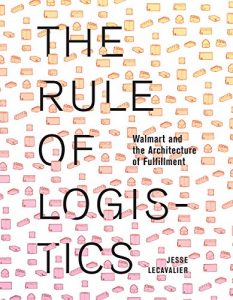Every time you wheel a shopping cart through one of Walmart’s more than 10,000 stores worldwide, or swipe your credit card or purchase something online, you enter a mind-boggling logistical regime. Even if you’ve never shopped at Walmart, its logistics have probably affected your life. The Rule of Logistics makes sense of its spatial and architectural ramifications by analyzing the stores, distribution centers, databases, and inventory practices of the world’s largest corporation.
The Rule of Logistics tells the story of Walmart’s buildings in the context of the corporation’s entire operation, itself characterized by an obsession with logistics. Beginning with the company’s founding in 1962, Jesse LeCavalier reveals how logistics—as a branch of knowledge, an area of work, and a collection of processes—takes shape and changes our built environment. Weaving together archival material with original drawings, LeCavalier shows how a diverse array of ideas, people, and things—military theory and chewing gum, Howard Dean and satellite networks, Hudson River School painters and real estate software, to name a few—are all connected through Walmart’s logistical operations and in turn are transforming how its buildings are conceptualized, located, built, and inhabited.
A major new contribution to architectural history and theory, The Rule of Logistics helps us understand how retailing today is changing our bodies, brains, buildings, and cities and predicts what future forms architecture might take when shaped by systems that exceed its current capacities.






